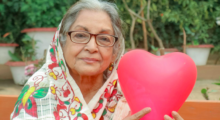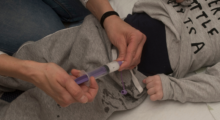Today, SevenPonds speaks with Adriana Marchione, MA, REAT, RSMT, a Registered Expressive Arts Therapist and Registered Somatic Movement Therapist. Currently based in San Francisco, California, she is the founder of a well-established arts and healing practice called Creative Source and a core faculty member at Tamalpa Institute in San Rafael, California, a training center for movement-based expressive arts therapy. She holds a BA in Studio Art and a MA in Psychology. She specializes in addiction/recovery and trauma. She is the creator of a project called “When the Fall Comes,” which consists of a poetry chapbook, a performance about loss, memory and dreams, and a film that will be completed in the coming months. Today, she discusses expressive arts therapy, her personal approach, how she was inspired to work in the field and what the benefits of expressive arts are for people dealing with loss and grief.
Zoë: What is expressive arts therapy?
Adriana: It is when you use many forms of different artistic forms to help people with their healing—physically, emotionally, mentally and spiritually. At the Tamalpa Institute, where I work, we call our method the Life/Art Process. I work with movement and dance. We often start with having people learn to work with their bodies and discover their ranges of motion. Expressive arts include everything from creative writing, such as poetry and storytelling, to visual arts, movement/dance and performance work. The expressive arts can support people to produce creative work from their personal stories, events and emotions that might be difficult to talk about.
Zoë: What is your approach?
Adriana: What specifically I do depends on the clients. I do both group and individual sessions. I try to find a way into their personal stories. I help them identify with different forms of expression instead of just talking, which is very cerebral and linear. There are many different approaches for this kind of therapy, like drawing, movement and even breathing. I focus on accessing more unconscious messages that the body has and finding out what the body would say if it could talk. It’s about the connection to themselves through the body. I help people find a container for their painful feelings. My business, Creative Source, is about sourcing that creativity through bodies, imaginations, memories and emotions.
Zoë: What inspired you to work in this field?
Adriana: I started out as a visual artist working in photography and mixed media. I found it was hard to survive financially as a working artist in my twenties. After a struggle with alcohol for seven years and becoming sober, I started using my art as a way of learning to heal rather than to exhibit. It was more intimate and helpful for me and I wanted to share that. I received further education in order to share my knowledge with others. I wanted to show how we can use the arts to deal with trauma and addiction. How I got into the field and my specialty became part of that.
Zoë: What are the benefits of expressive arts when dealing with loss and grief?
Adriana: In 2007, I lost my husband to lung cancer, and a year later I lost my father to a heart condition. I started using the arts to deal with my own loss. I was learning by the experience of loss itself and reading about grief. I was receiving grief counseling and had clients start coming to see me who were dealing with their own losses. The arts are helpful for so many issues. It is not specific to addiction or mental health or the like. In a broader way, they apply to many issues. Arts hold the very pain and give us a way to express. A drawing, poem or dance can hold pain and it can give us a little bit of a break. The arts can give us a little distance and get us out of our heads. Each offers a different perspective and allows things to be expressed, relieved and sometimes resolved. Using the arts to tell the story can give new resources for us, bring insight and offer relief in the body. Tears, anger and frustrations can be let out. The arts bring us into our senses. They helps draw us into the moment and that mindfulness is really useful in loss and grief. It can feel like a little break and vacation from the loss and grief.
Adriana Marchione’s 3 Tips on How Expressive Arts Support Grief:
1) Often grief is very focused on the past and the person who has died; the arts can support us to share what is true for us, and to unravel some of the complicated emotions around loss (guilt, anger, regret, etc.).
2) Writing our experiences about loss, drawing them out, or dancing them on our own or with an audience can offer a sense of empowerment.
3) Being in an expressive arts environment, where other people are exploring the arts together, can provide a strong sense of connection and validation.
Zoë: How did it feel to share your own experiences of loss and grief throughout your film?
Adriana: To make it clear, I started writing poetry when my husband was sick with cancer in 2007, and then continued to write poetry after he died. I used the poems to create a performance that I performed one time in January 2013. I was inspired by the feedback to do it again in October 2013 to a broader audience. The film titled, “When the Fall Comes” was created in connection with the performance, and will be released later in the year. “When the Fall Comes” will enter the film festival circuit before it is released to the public. Sharing my own stories felt incredibly vulnerable because I didn’t know how my experience would translate for other people. I had to revisit some things that hadn’t been resolved yet. Some of that was challenging. It was also very freeing and I had very supportive people—a wonderful choreographer and crew. It was very helpful in the end. It helped me find new solutions and expand my life tremendously. I learned how to embrace a new relationship while finding myself healthy and alive. It was painful, but it was a human experience. I could recognize that the losses were not a tragedy even though they were very sad. It taught me to live more fully and to help me learn how to help others with their own grieving. It was gratifying and that sense of purpose really gave me energy.
Zoë: Thank you so much for speaking with us!
Adriana: Thank you so much! I really appreciate it.
More SevenPonds interviews:

 What is Expressive Arts Therapy? An Interview with Adriana Marchione
What is Expressive Arts Therapy? An Interview with Adriana Marchione





 “Summons” by Aurora Levins Morales
“Summons” by Aurora Levins Morales
 How To Dispose of a Body In Space
How To Dispose of a Body In Space
 AMA Adopts New Policies Expanding Access to Palliative Care
AMA Adopts New Policies Expanding Access to Palliative Care














